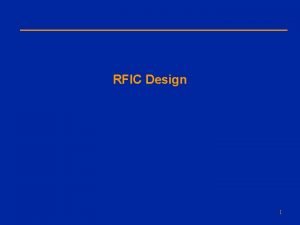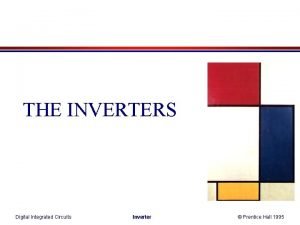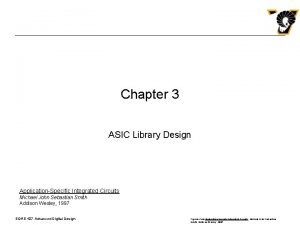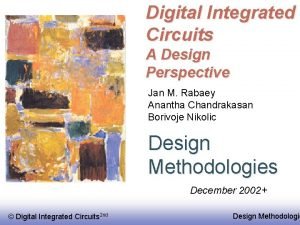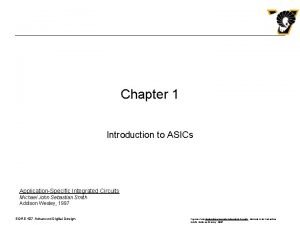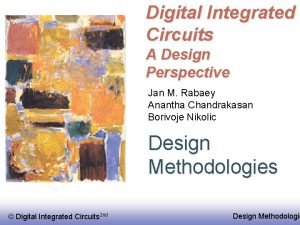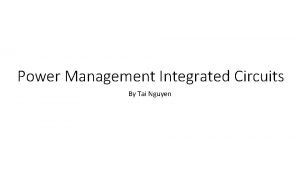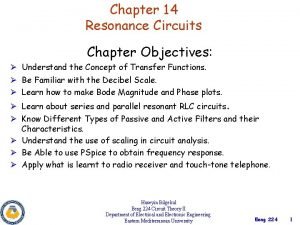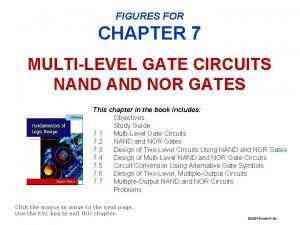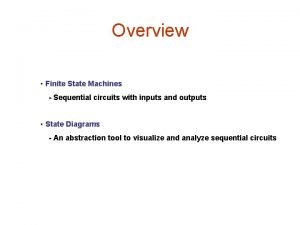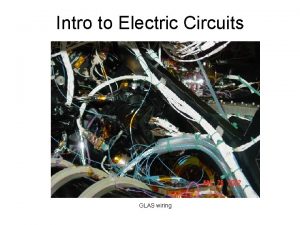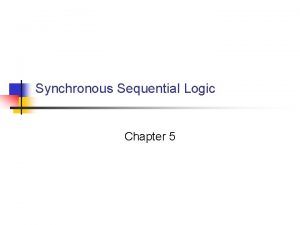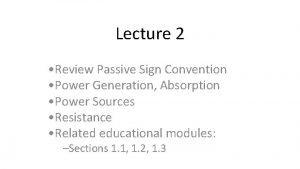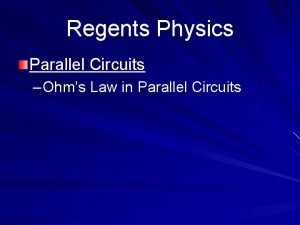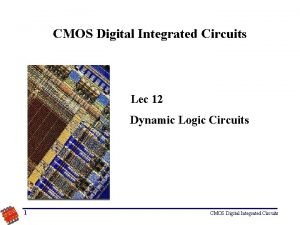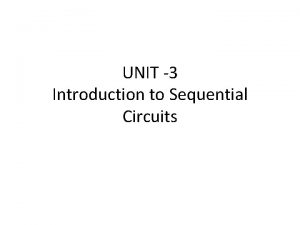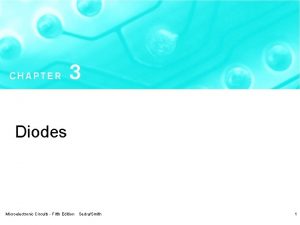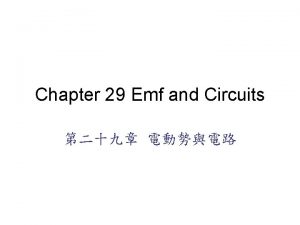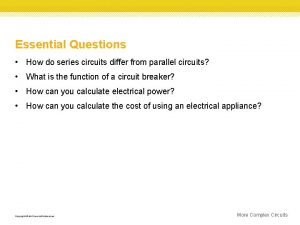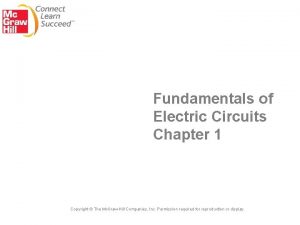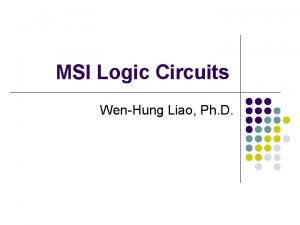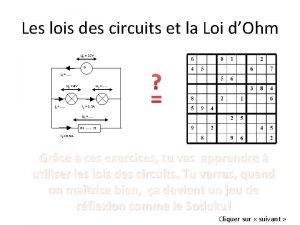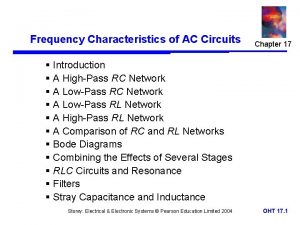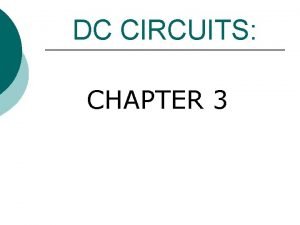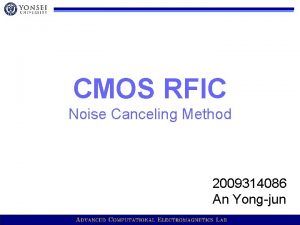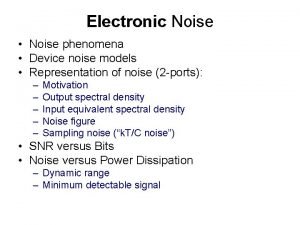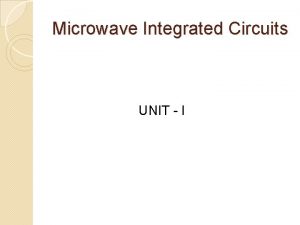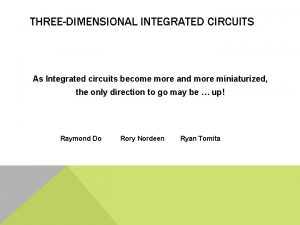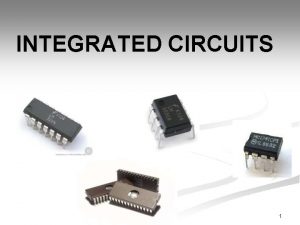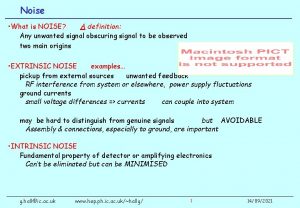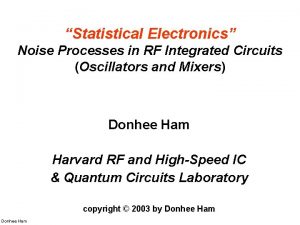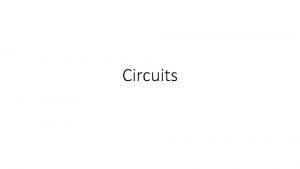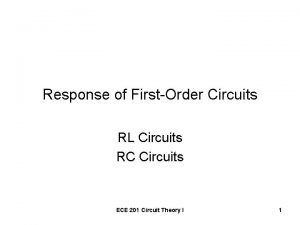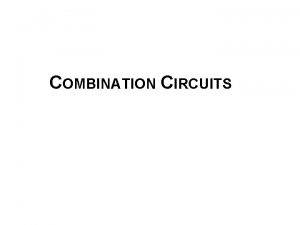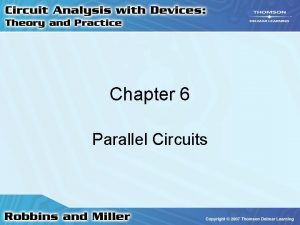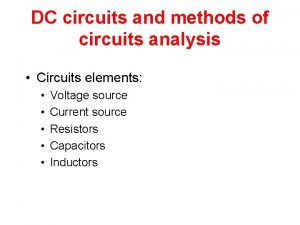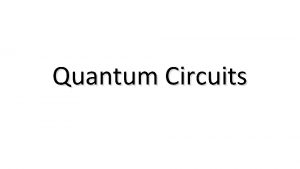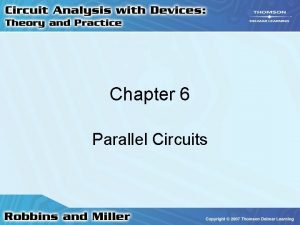RF INTEGRATED CIRCUITS UNITIII RFIC UNITIII Noise Any

















































- Slides: 49

RF INTEGRATED CIRCUITS UNIT-III

RFIC UNIT-III Noise • “Any unwanted input” • Limits systems ability to process weak signals • Sources: 1. Random noise in resistors and transistors 2. Mixer noise 3. Undesired cross-coupling noise 4. Power supply noise • Dynamic range – capability of detecting weak signals in presence of large-amplitude signals

3 1. Thermal noise is observed in any system having thermal losses and is caused by thermal agitation of charge carriers. Thermal noise is also called Johnson-Nyquist noise. (Johnson, Nyquist: 1928, Schottky: 1918). An example of thermal noise can be thermal noise in resistors.




7 5. 2. 3. 1/f noise Thermal noise and shot noise are irreducible (ever present) forms of noise. They define the minimum noise level or the ‘noise floor’. Many devices generate additional or excess noise. The most general type of excess noise is 1/f or flicker noise. This noise has approximately 1/f power spectrum (equal power per decade of frequency) and is sometimes also called pink noise. 1/f noise is usually related to the fluctuations of the device properties caused, for example, by electric current in resistors and semiconductor devices. Curiously enough, 1/f noise is present in nature in unexpected places, e. g. , the speed of ocean currents, the flow of traffic on an expressway, the loudness of a piece of classical music versus time, and the flow of sand in an hourglass. No unifying principle has been found for all the 1/f noise sources. Reference: [3]

8 In electrical and electronic devices, flicker noise occurs only when electric current is flowing. In semiconductors, flicker noise usually arises due to traps, where the carriers that would normally constitute dc current flow are held for some time and then released. Although bipolar, JFET, and MOSFET transistors have flicker noise, it is a significant noise source in MOS transistors, whereas it can often be ignored in bipolar transistors (and some modern JFETs). References: [4] and [5]

9 An important parameter of 1/f noise is its corner frequency, fc, where the power spectral density equals the white noise level. A typical value of ff is 100 Hz to 1 k. Hz (MOSFET: 100 k. Hz). in ( f ), d. B -10 d. B/decade Pink noise White noise f, decades ff

Noise (contd. ) Ø “noisiness” of the signal measure = signal-to-noise ratio (frequency dependant) Ø Random noise l l External • • Atmospheric Interstellar • • • Thermal Flicker noise (low frequency) Shot noise Receiver internal

Noise factor • IEEE Standards: “The noise factor, at a specified input frequency, is defined as the ratio of (1) the total noise power per unit bandwidth available at the output port when noise temperature of the input termination is standard (290 K) to (2) that portion of (1) engendered at the input frequency by the input termination. ”

Noise factor (cont. ) • It is a measure of the degradation of SNR due to the noise added • Implies that SNR gets worse as we process the signal • Spot noise factor • The answer is the bandwidth

Noise factor (cont. ) • Quantitative measure of receiver performance wrt noise for a given bandwidth • Noise figure – Typically 8 -10 db for modern receivers • Multistage (cascaded) system

Noise Figure • Definition • As a function of device G: Power gain of the device

NF of Cascaded Stages Sin/Nin Sout/Nout G 1, NF 1 Gi, NFi GK, NFK • Overall NF dominated by NF 1 [1] F. Friis, “Noise Figure of Radio Receivers, ” Proc. IRE, Vol. 32, pp. 419 -422, July 1944.

Simple Model of Noise in MOSFET • Flicker noise Vg Id Vi – Dominant at low frequency • Thermal noise – g: empirical constant 2/3 for long channel much larger for short channel – PMOS has less thermal noise • Input-inferred noise

Noise Approximation Noise spectral density 1/f noise Thermal noise dominant Thermal noise Band of interest Frequency

Low-Noise Amplifier

Low-Noise Amplifier • First gain stage in receiver – Amplify weak signal • Significant impact on noise performance – Dominate input-referred noise of front end • Impedance matching – Efficient power transfer – Better noise performance – Stable circuit

RF Receiver Antenna BPF 1 LNA BPF 2 Mixer BPF 3 IF Amp Demodulator RF front end LO

LNA Design Consideration • • Noise performance Power transfer Impedance matching Power consumption Bandwidth Stability Linearity




S-Parameters • Parameters for two-port system analysis • Suitable for distributive elements • Inputs and outputs expressed in powers – Transmission coefficients – Reflection coefficients

S-Parameters • S 11 – input reflection coefficient with the output matched • S 21 – forward transmission gain or loss • S 12 – reverse transmission or isolation • S 22 – output reflection coefficient with the input matched

S-Parameters I 1 S Z 1 Vs 1 I 2 V 1 Z 2 Vs 2

A First LNA Example io Rs • Assume – – Vs Rs Vs No flicker noise ro = infinity Cgd = 0 Reasonable for appropriate bandwidth • Effective transconductance 4 k. TRs Vgs gm. Vgs 4 k. Tggm

Power Gain • Voltage input • Current output

Series-Shunt Feedback RF • Broadband matching RL Rs Vs Ra Rs Cgs Vs iout RF Vgs Ra gm. Vgs RL • Could be noisy

Cascode LL Vbias Rs Vo M 2 Vd 1 Lg M 1 Vs Ls • Isolation to improve S 12 @ high frequency – Small range at Vd 1 – Reduced feedback effect of Cgd • Improve noise performance

MIXERS Frequency translation device Convert RF frequency to a lower IF or base band for easy signal processing in receivers Convert base band signal or IF frequency to a higher IF or RF frequency for efficient transmission in transmitters


An ideal nonlinearity mixer If x(t)y(t) x(t) y(t) Then the output is down convert up convert



Suarelaw mos Voltage temperature equivalent






Simple Switching Mixer (Single Balanced Mixer) • The transistor M 1 converts the RF voltage signal to the current signal. • Transistors M 2 and M 3 commute the current between the two branches.

Double Balanced Mixer • Strong LO-IF feed suppressed by double balanced mixer. • All the even harmonics cancelled. • All the odd harmonics doubled (including the signal).


Sub-sampling Mixer

In sample(track) mode: M 1 through M 5 turned on while M 6 and M 7 are placed in the OFF state Devices M 3, M 4 and M 5 put a voltage equal to the Common Mode Voltage levels VCM of the sampling capacitors while Input switches M 1, and M 2 connect the capacitors to the RF Input signal. Because M 6 and M 7 are open the op-amp is irrelevant in this tracking mode the tracking bandwidth is simply set by the RC time constant R. . is Total Switching Resistance and C. . is Sampling capacitance In hold mode: In hold mode all switches are reversed, so that the conducting Transistors are M 6 and M 7 are the two feedback devices. In this mode the circuit degenerates to a pair of charged capacitors feeding back around the op-amp • Properly designed track-and-hold circuit works as subsampling mixer. • The sampling clock’s jitter must be very small • Subsampling mixers can exhibit large noise figures. • Subsampling can exhibit mixers high linearity

• Properly designed track-and-hold circuit works as sub -sampling mixer. • The sampling clock’s jitter must be very small • Noise folding leads to large mixer noise figure. • High linearity

Gilbert Mixer • Use a differential pair to achieve the transconductor implementation • This is the preferred mixer implementation for most radio systems!
 Direct conversion receiver
Direct conversion receiver Rf ic design course
Rf ic design course Advantages of parallel circuits over series circuit
Advantages of parallel circuits over series circuit Pcm companding
Pcm companding Integrated circuits
Integrated circuits Jan m rabaey digital integrated circuits
Jan m rabaey digital integrated circuits Application specific integrated circuits smith pdf
Application specific integrated circuits smith pdf Digital integrated circuits
Digital integrated circuits Digital integrated circuits: a design perspective
Digital integrated circuits: a design perspective Ultra large scale
Ultra large scale Integrated circuit
Integrated circuit Application specific integrated circuits
Application specific integrated circuits Digital integrated circuits a design perspective
Digital integrated circuits a design perspective Characteristics of digital integrated circuits
Characteristics of digital integrated circuits Integrated circuits
Integrated circuits Power management integrated circuits
Power management integrated circuits A tree is a connected graph without any circuits
A tree is a connected graph without any circuits There isn't any pasta
There isn't any pasta Any to any connectivity
Any to any connectivity Any question atau any questions
Any question atau any questions Planning electrical circuits
Planning electrical circuits Parallel resonance
Parallel resonance Multilevel nand circuits
Multilevel nand circuits Finite state machine sequential circuits
Finite state machine sequential circuits Parallel circuits
Parallel circuits Bill nye static electricity
Bill nye static electricity Circuits
Circuits Sequential circuits
Sequential circuits Passive convention
Passive convention Parallel circuit laws
Parallel circuit laws Different types of circuits
Different types of circuits Snap circuits instructions
Snap circuits instructions Babinski sign
Babinski sign Synchronous dynamic pass transistor circuits
Synchronous dynamic pass transistor circuits Analogy between electric and magnetic circuits
Analogy between electric and magnetic circuits First order rc
First order rc D flip flop
D flip flop Circuits
Circuits Conceptual physics chapter 35
Conceptual physics chapter 35 Small signal model
Small signal model Adco circuits
Adco circuits Circuits
Circuits How do series and parallel circuits differ
How do series and parallel circuits differ Types of elements in electrical circuits
Types of elements in electrical circuits Minecraft and gate
Minecraft and gate Msi logic
Msi logic Loi des circuits
Loi des circuits Solved: ph dincussion ac circuits session 12 q2. low-pass
Solved: ph dincussion ac circuits session 12 q2. low-pass Thevenin's theorem solved problems dc circuits
Thevenin's theorem solved problems dc circuits Superposition electric circuits
Superposition electric circuits

